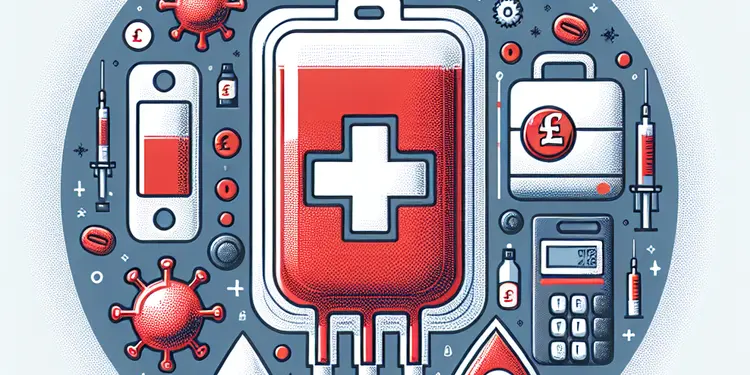
Find Help
More Items From Ergsy search
-
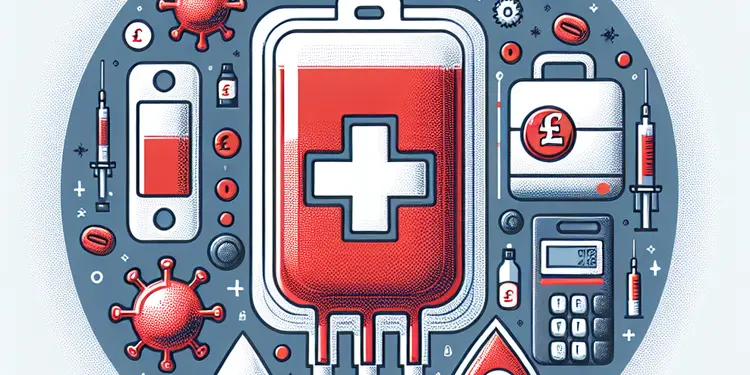
Is HTLV a risk in blood transfusions?
Relevance: 100%
-

What diseases can be spread by blood transfusions?
Relevance: 60%
-

Are there risks associated with blood transfusions?
Relevance: 57%
-
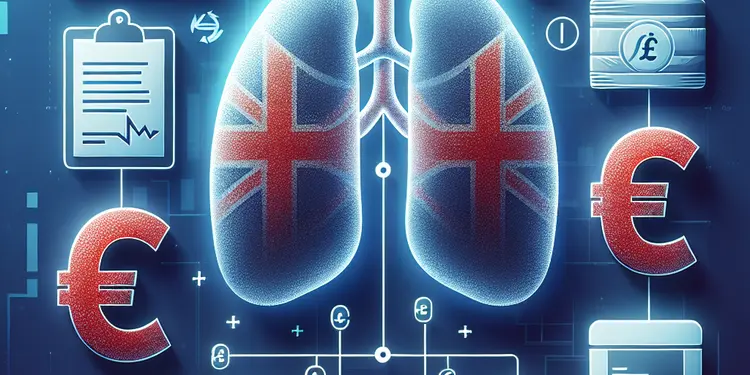
Is Hepatitis B a risk in blood transfusions?
Relevance: 55%
-

Blood Product Transfusions
Relevance: 49%
-

What is a blood transfusion?
Relevance: 48%
-
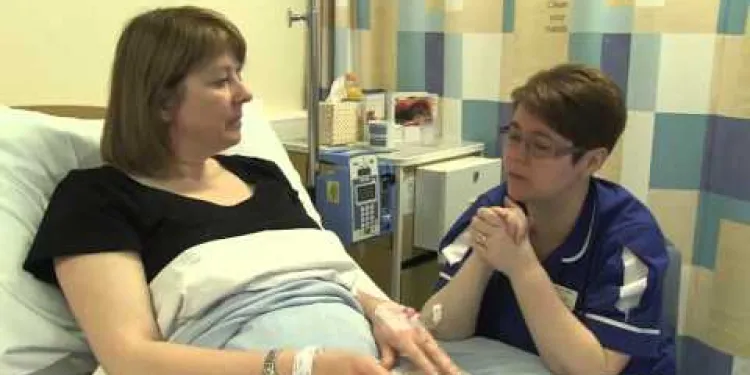
Blood Transfusion
Relevance: 47%
-

Is there an age limit for receiving blood transfusions?
Relevance: 45%
-

What other viruses are tested for in blood donations?
Relevance: 45%
-
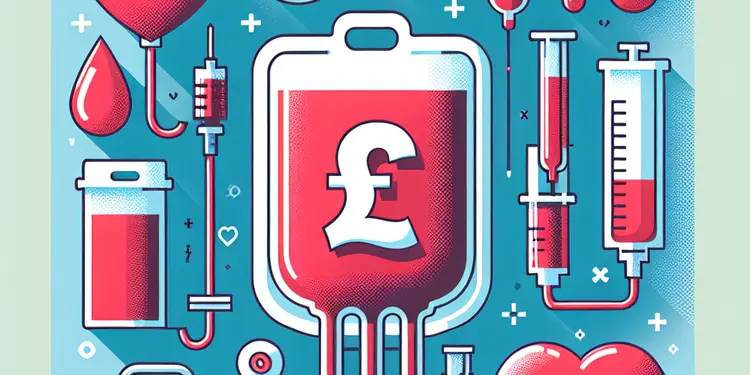
Can HIV be transmitted through blood transfusions?
Relevance: 43%
-

Is Chagas disease a concern with blood transfusions?
Relevance: 43%
-
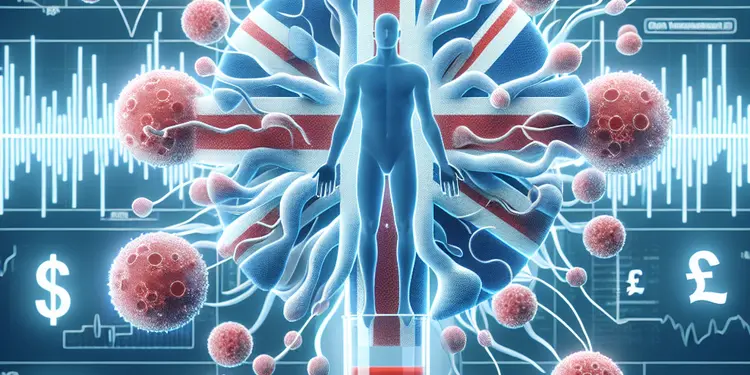
Can syphilis be transmitted via blood transfusion?
Relevance: 43%
-
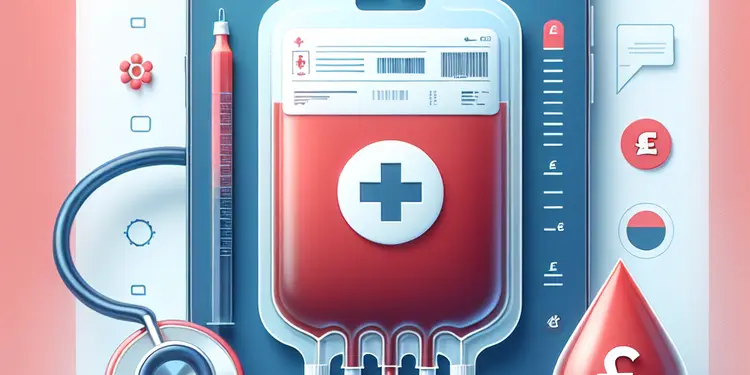
Can bacterial infections be transmitted through blood transfusion?
Relevance: 42%
-
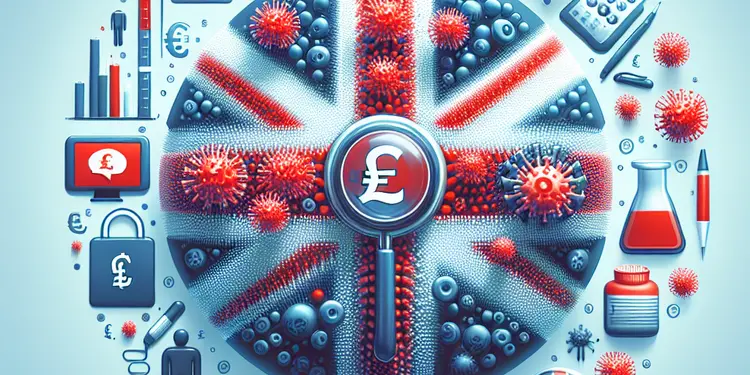
Is Zika virus screened for in blood transfusions?
Relevance: 42%
-

Why might someone need a blood transfusion?
Relevance: 42%
-

Are there any parasites that can be transmitted through blood transfusions?
Relevance: 42%
-

Is malaria still a concern for blood transfusion safety?
Relevance: 42%
-
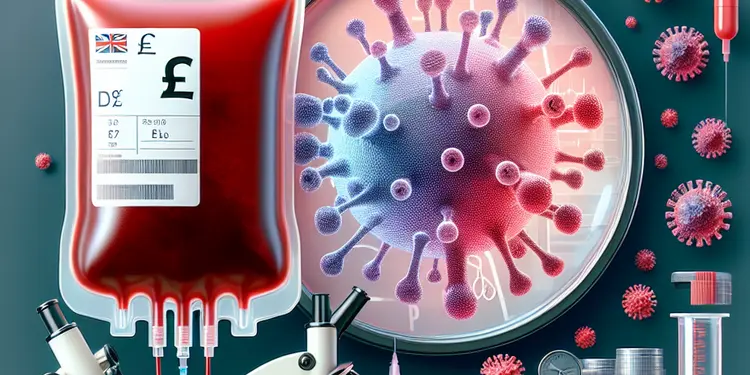
What is the most common disease transmitted by blood transfusion?
Relevance: 42%
-
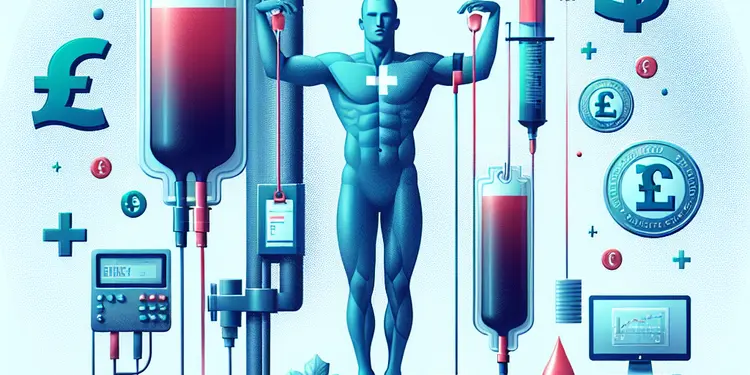
Can someone have a reaction to a mismatched blood transfusion?
Relevance: 42%
-
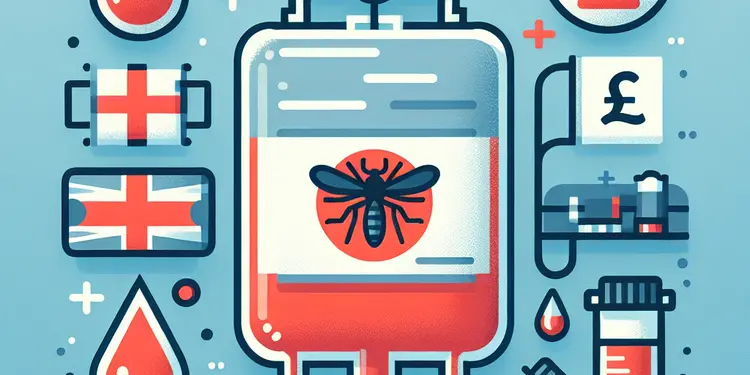
Can Dengue fever be transmitted through blood transfusions?
Relevance: 41%
-
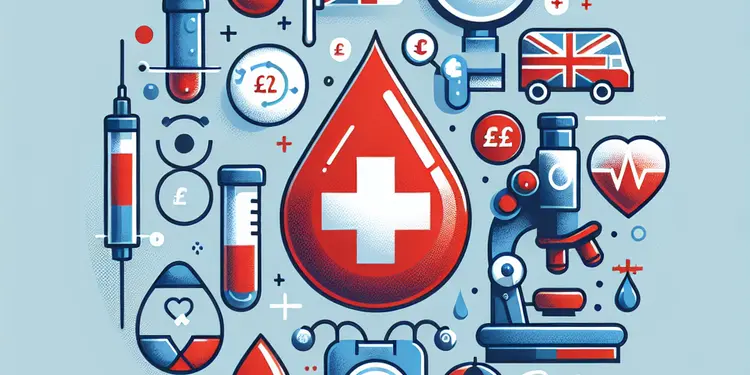
How do healthcare providers match blood for transfusions?
Relevance: 41%
-
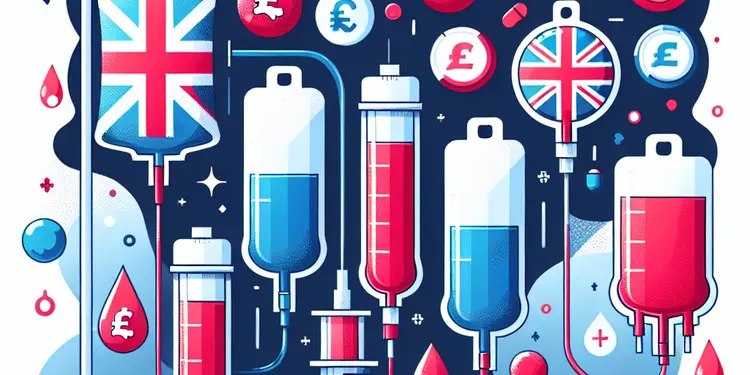
What types of blood products can be transfused?
Relevance: 41%
-
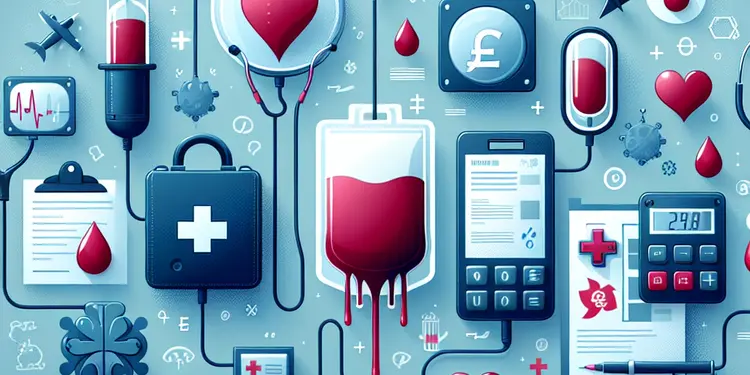
Can certain medical conditions prevent receiving blood transfusions?
Relevance: 41%
-
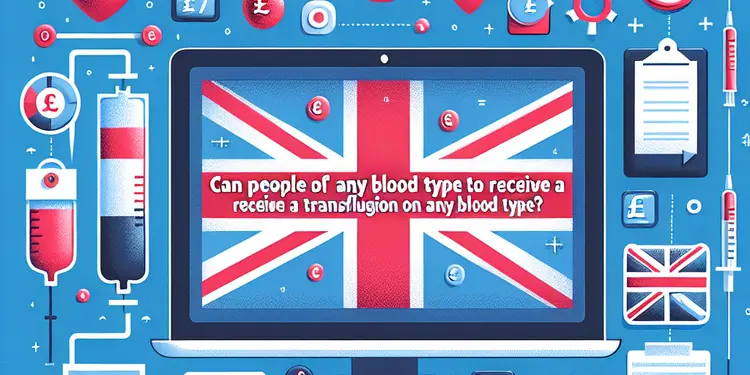
Can people of any blood type receive a transfusion of any blood type?
Relevance: 41%
-

How long does a blood transfusion take?
Relevance: 41%
-
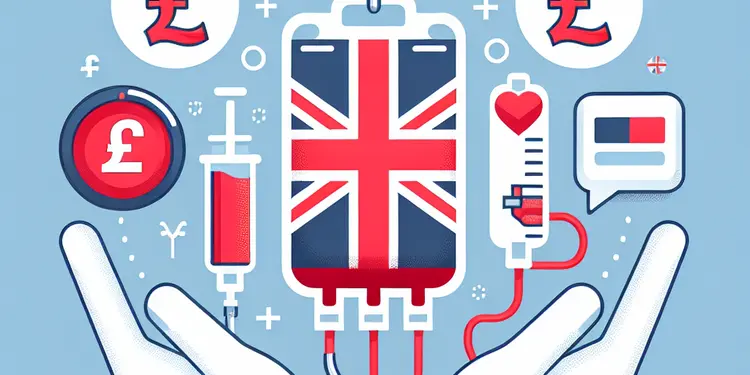
Can COVID-19 be transmitted through blood transfusions?
Relevance: 40%
-
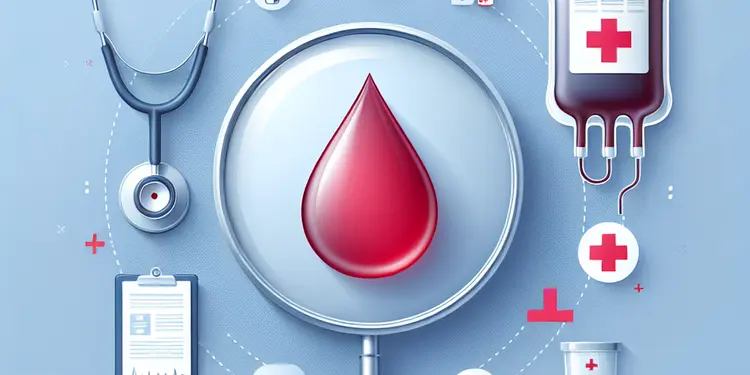
How do doctors determine how much blood is needed for a transfusion?
Relevance: 40%
-
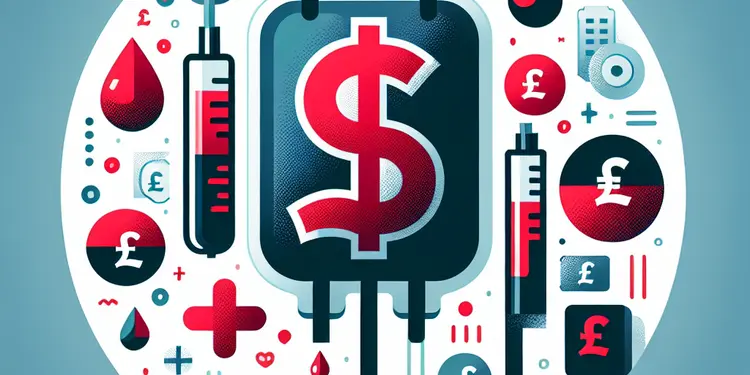
What are some common reasons blood transfusions are needed?
Relevance: 40%
-
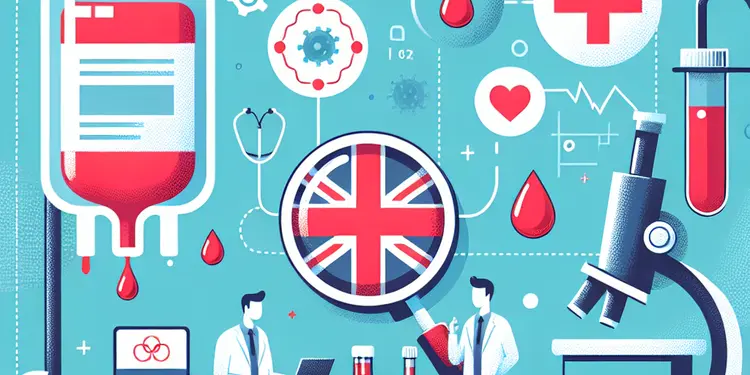
Can you get any prion diseases from blood transfusion?
Relevance: 39%
-
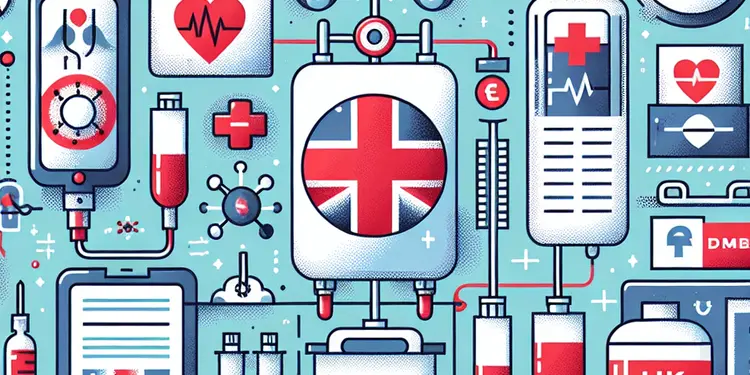
What measures are taken to prevent disease transmission in blood transfusions?
Relevance: 37%
-

Are new emerging pathogens a risk for blood safety?
Relevance: 36%
-
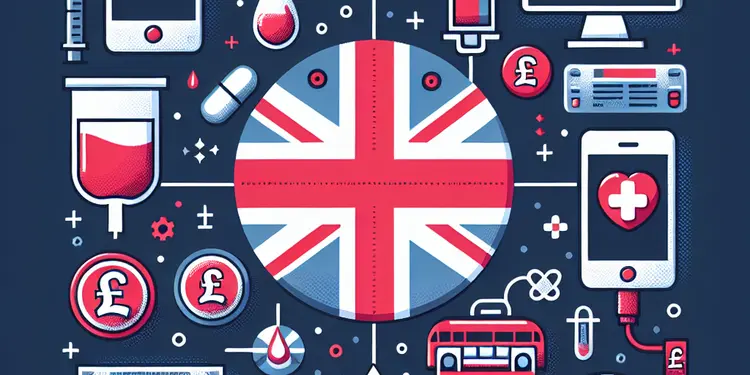
Is blood used for transfusions safe?
Relevance: 34%
-

Can cytomegalovirus (CMV) be spread through transfusions?
Relevance: 34%
-

What is plasma, and why might it be transfused?
Relevance: 33%
-

How is blood screened to prevent disease transmission?
Relevance: 33%
-

Are there global differences in screening for blood transfusions?
Relevance: 32%
-
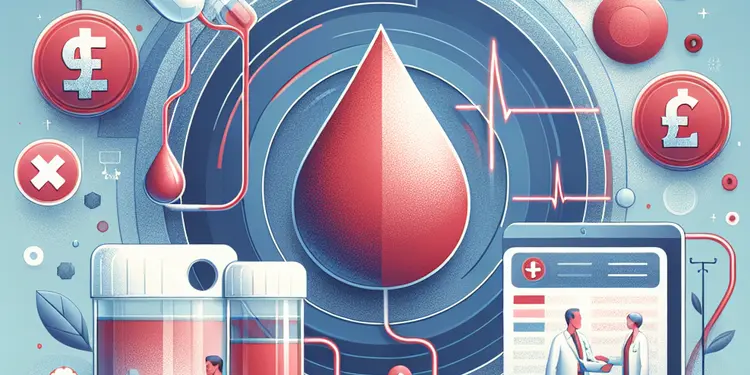
What kind of follow-up care is needed after a blood transfusion?
Relevance: 28%
-

What should a patient expect after a blood transfusion?
Relevance: 28%
-

What are the risks of having high blood pressure?
Relevance: 27%
-

What are the risks associated with a C-section?
Relevance: 24%
Introduction to HTLV and Blood Transfusions
Human T-lymphotropic virus (HTLV) is a type of retrovirus that affects T-cells, a crucial component of the immune system. There are several types, with HTLV-I and HTLV-II being the most common. While primarily associated with regions such as Japan and the Caribbean, HTLV has a global presence, with cases reported in the UK as well. Understanding the risk of HTLV in blood transfusions is crucial for ensuring the safety of blood supplies.
HTLV Transmission Through Blood Transfusions
HTLV can be transmitted through various routes, including sexual contact, breastfeeding, and blood transfusions. The risk of transmission through transfusions is a significant concern, as the virus can be present in infected donor blood. Without proper screening, HTLV can be inadvertently transferred to recipients, leading to potential health issues. In the UK, where blood transfusion services prioritize safety, understanding and mitigating this risk is essential.
Screening and Safety Measures in the UK
The UK has implemented stringent screening protocols to reduce the risk of HTLV transmission through blood transfusions. Since 2002, the National Health Service Blood and Transplant (NHSBT) has enforced mandatory screening for HTLV-I and HTLV-II in donated blood. This policy ensures that blood products are tested for the presence of the virus, significantly minimizing the risk to recipients.
In addition to screening, the UK blood transfusion services employ other safety measures such as donor deferrals. Individuals from high-prevalence areas or those with a known history of HTLV infection are deferred from donating blood. These measures collectively help maintain a safer blood supply.
Public Awareness and Education
Public awareness and education about HTLV are vital components of managing its risk in blood transfusions. Increasing public knowledge can lead to better donor self-disclosure and adherence to deferral criteria. Healthcare providers also play a critical role in educating potential donors and recipients about the risks and safety protocols in place to mitigate HTLV transmission during blood transfusions.
Conclusion
While HTLV presents a potential risk in blood transfusions, the UK has implemented comprehensive measures to address this concern. Through mandatory screening, donor deferrals, and public education, the risk of HTLV transmission in blood transfusions remains low. Continuing these efforts is crucial to ensuring the safety and reliability of the blood supply, protecting both donors and recipients from potential health risks associated with HTLV.
Introduction to HTLV and Blood Transfusions
Human T-lymphotropic virus, or HTLV, is a kind of virus. It affects T-cells, which help the body fight germs. There are different types of HTLV. HTLV-I and HTLV-II are the most common. HTLV is found in places like Japan and the Caribbean, but it is in other parts of the world too, like the UK. It is important to know how HTLV affects blood transfusions to keep blood safe.
HTLV Transmission Through Blood Transfusions
HTLV can spread in different ways, such as through sex, breastfeeding, and blood transfusions. If the virus is in a donor's blood, it can spread through a transfusion. This can cause health problems. In the UK, it is very important to make blood transfusions safe and to know how to lower the risk of HTLV spreading this way.
Screening and Safety Measures in the UK
The UK checks blood donations carefully to keep HTLV from spreading through transfusions. Since 2002, the UK tests all donated blood for HTLV-I and HTLV-II. This makes sure the blood is safe. The UK also stops people from giving blood if they might have HTLV. People from places where HTLV is common or who have had HTLV cannot donate. These steps help keep the blood supply safe.
Other safety steps are also taken, like not letting people donate if they have been in high-risk places or might have HTLV. Together, these actions help keep blood safe.
Public Awareness and Education
Teaching people about HTLV is important. It helps people know if they should donate blood or not. Doctors and nurses talk to people about HTLV and how to be safe. This helps make sure everyone knows the rules to keep blood safe.
Conclusion
HTLV can be a problem for blood transfusions. But in the UK, many steps are taken to prevent this. Testing blood, checking donors, and teaching people all help keep blood safe. These actions protect people who donate blood and people who get blood from getting sick from HTLV.
Frequently Asked Questions
What is HTLV?
HTLV stands for Human T-cell Lymphotropic Virus, a retrovirus that can cause disease in humans.
How is HTLV transmitted?
HTLV is primarily transmitted through blood, sexual contact, and from mother to child via breastfeeding.
Is HTLV a concern in blood transfusions?
Yes, HTLV can be transmitted through blood transfusions if the blood is not screened for the virus.
How common is HTLV in blood donors?
The prevalence of HTLV in blood donors varies by region, but it is generally low in many parts of the world.
Do blood banks test for HTLV?
Yes, most blood banks in developed countries test for HTLV-1 and HTLV-2 to prevent transmission through transfusions.
What types of HTLV are screened for in blood donations?
Blood donations are typically screened for HTLV-1 and HTLV-2.
What measures are in place to ensure blood safety with regard to HTLV?
Blood safety measures include donor screening, laboratory testing for HTLV, and deferral of high-risk donors.
What happens if a blood donor is found to have HTLV?
If a blood donor tests positive for HTLV, they are usually deferred from donating blood in the future and are counseled regarding the infection.
Can HTLV be cured?
Currently, there is no cure for HTLV, but treatments are available to manage symptoms and complications.
What diseases are associated with HTLV?
HTLV is associated with adult T-cell leukemia/lymphoma (ATL) and HTLV-associated myelopathy/tropical spastic paraparesis (HAM/TSP).
How effective is HTLV screening in preventing transmission via blood transfusion?
HTLV screening is highly effective at preventing transmission, significantly reducing the risk of transfusion-transmitted HTLV.
Are there different guidelines for HTLV screening in various countries?
Yes, HTLV screening guidelines can vary by country based on prevalence rates and local health policies.
Can individuals infected with HTLV donate blood?
No, individuals known to be infected with HTLV are generally not allowed to donate blood.
What is the probability of contracting HTLV from a blood transfusion?
With the implementation of screening protocols, the probability is very low, but the exact risk varies depending on the region and screening effectiveness.
How long has HTLV screening been a standard practice in blood banks?
HTLV screening has been a standard practice in many developed countries since the late 1980s or early 1990s.
Do all blood products undergo HTLV testing?
Yes, standard practice is to screen all blood products for HTLV to ensure safety.
Is HTLV testing mandatory in all countries?
HTLV testing is not mandatory in all countries; it depends on regional risk assessments and health regulations.
What populations are at greater risk for HTLV infection?
Populations in certain regions like Japan, the Caribbean, and parts of Africa have higher rates of HTLV infection.
Can HTLV transmission be prevented outside of transfusion settings?
Yes, HTLV transmission can be prevented by safe sexual practices, avoiding sharing needles, and by screening breast milk for mothers in high-risk areas.
What should a recipient of a blood transfusion do if they are concerned about HTLV?
Recipients should discuss any concerns with their healthcare provider, who can provide information on the screenings performed and any risks involved.
What is HTLV?
HTLV is a virus. It stands for Human T-cell Leukemia Virus. It can infect people.
HTLV is not very common. Most people with the virus do not feel sick.
If you want to learn more about HTLV, you can:
- Ask a doctor or nurse.
- Look it up with help from a friend or family member.
- Use easy-to-read health websites.
HTLV is a long word that stands for Human T-cell Lymphotropic Virus. It is a type of virus that can make people sick.
How does HTLV spread from person to person?
HTLV is a virus. It spreads in three main ways:
- Breastfeeding: A mother with HTLV can pass it to her baby through her breast milk.
- Blood: You can catch HTLV if you get blood from someone who has the virus, like in a blood transfusion.
- Sex: HTLV can spread during unprotected sex.
Here are some tips to stay safe:
- Talk to a doctor about safe ways to feed your baby if you have HTLV.
- Make sure blood is tested before you get a transfusion.
- Use protection, like condoms, during sex.
If you need help understanding this, ask a friend or a healthcare worker to explain it to you. There are also audio tools and picture guides that can help.
HTLV can spread in a few ways. It can spread through blood, by sexual contact, and from a mother to her baby when breastfeeding.
To help understand better, you can use tools that read out loud or ask someone to explain it to you.
Should we worry about HTLV in blood transfusions?
Sometimes, people need new blood. This is called a blood transfusion.
HTLV is a virus that can be in blood.
People who give blood are tested for HTLV to keep it safe.
Most of the time, blood transfusions are very safe.
If you have questions or feel worried, talk to your doctor or a nurse. They can help you understand.
Yes, HTLV can spread when people get blood from someone else. If the blood is not checked for this virus, it can pass to the new person.
How often do blood donors have HTLV?
Let's learn about HTLV together!
HTLV is a virus. It's not often found in people who give blood. This means that most blood donors do not have HTLV.
If you want to learn more, you can:
- Ask a doctor or nurse for help.
- Use online tools that read text out loud.
- Look at pictures or videos about HTLV.
These things can make learning easier and more fun!
HTLV is a virus. Not many blood donors have it. It is different in each part of the world, but usually, it is not common.
Do Blood Banks Check for HTLV?
Blood banks test the blood they receive. They want to make sure the blood is safe. They check for many viruses. One of these viruses is called HTLV.
If you want help reading, you can:
- Ask someone to read it with you.
- Use your finger to follow the words.
- Look at one sentence at a time.
Yes, most places that collect blood in big, rich countries check for HTLV-1 and HTLV-2. This is to make sure these viruses don't get passed to people through blood donations.
What kinds of HTLV do we check for in blood donations?
When we give blood, doctors check it for certain things. One of these things is called HTLV. HTLV is a type of virus.
There are two main kinds of HTLV that doctors look for:
- HTLV-1: This kind can make people sick. It's important to check for it.
- HTLV-2: This is another kind that doctors check for. It can also make people sick.
Doctors want to make sure the blood is safe for others to use. This is why they check for these viruses. Tools like pictures or videos can help explain this more.
When you give blood, it is checked for two things called HTLV-1 and HTLV-2.
How do we keep blood safe from HTLV?
We have steps to make sure blood is safe and clean. HTLV is a virus that can be in blood. To keep blood safe, we:
- Test blood for HTLV. This helps us find out if the virus is there.
- Use special questions to learn about the person giving blood. We ask if they might have HTLV.
- Train people who work with blood. They learn how to keep blood safe.
These steps help everyone get safe blood.
Tools that might help you understand more:
- Talking to a doctor or nurse can help. They know a lot about blood and can answer questions.
- Using pictures or diagrams might make things clearer.
- Reading out loud with someone can make it easier to understand.
Keeping blood safe means checking people who want to give blood. It also means testing the blood for something called HTLV. If someone has a high chance of having problems, they should not give blood.
What if a blood donor has HTLV?
If a person giving blood tests positive for HTLV, they cannot give blood again. They will talk to a doctor or nurse to learn more about the infection.
Can HTLV be cured?
HTLV is a virus that can make people sick. Right now, there is no medicine to make HTLV go away completely. Doctors can help people feel better if they are sick from HTLV.
If you want more help or tools, ask a doctor or nurse. They can give you good advice.
Right now, there is no medicine to make HTLV go away. But doctors can help with the symptoms and problems it causes.
What illnesses can you get from HTLV?
HTLV is a virus that can make some people sick. Here are some illnesses that people with HTLV might get:
- HTLV can sometimes cause a blood disease called adult T-cell leukemia/lymphoma.
- It can also lead to nervous system problems, like walking or muscle weakness. This is called HAM/TSP.
- Some people might have skin problems or joint pain.
If you have HTLV, it is good to talk with a doctor. They can help you stay healthy. Reading tools and software can read out loud, which can help you understand better.
HTLV is linked to diseases like ATL, which affects blood cells, and HAM/TSP, which affects nerves.
How good is checking for HTLV in stopping its spread through blood transfusions?
HTLV is a virus. Blood transfusions can pass it from one person to another.
Doctors check blood for HTLV. This helps stop it from spreading.
Some tools that can help you understand:
- Ask a friend or family member to explain if you are confused.
- Use pictures or diagrams to see how it works.
- Use a dictionary for words you don’t know.
Testing for HTLV is very good at stopping it from spreading. This makes it much safer when people get blood from someone else.
Do countries have different rules for checking HTLV?
Different countries have different rules for checking HTLV. This is because the number of people with HTLV and health rules are not the same everywhere.
Can people with HTLV give blood?
No, people with HTLV cannot give blood. HTLV is a virus. If people with HTLV give blood, the virus might spread to others.
Here are some ways to get help:
- Ask a doctor or nurse if you have any questions.
- Use a support group for more information.
No, people who have HTLV cannot give blood.
Can you get HTLV from a blood transfusion? How likely is it?
Screenings help find problems early. This means the chance of missing something is small. But, how small depends on where you are and how checks are done.
How long have blood banks been checking for HTLV?
In some countries, doctors have been checking for HTLV since the 1980s or 1990s.
Do they test all blood for HTLV?
Yes, we check all blood to make sure it is safe from HTLV. This is very important.
Do all countries have to test for HTLV?
HTLV testing is not needed everywhere. It depends on where you live and the local health rules.
Who is more likely to get HTLV?
More people in places like Japan, the Caribbean, and parts of Africa get HTLV.
How can we stop the spread of HTLV outside of blood transfusions?
Yes, you can stop the spread of HTLV. You can do this by:
- Having safe sex.
- Not sharing needles.
- Checking breast milk in high-risk places.
These are some helpful ways to keep everyone safe!
What to do if you are worried about HTLV after getting a blood transfusion?
If you got blood and feel worried about HTLV, here is what you can do:
- Talk to your doctor or nurse. They can help and answer your questions.
- Read easy-to-understand leaflets or guides about HTLV.
- Use picture books or videos to learn more.
These steps can help you feel better and know what to do. Remember, asking questions is always okay!
If you have questions, talk to your doctor. They can tell you more about the tests and any risks.
Useful Links
- Ergsy carfully checks the information in the videos we provide here.
- Videos shown by Youtube after a video has completed, have NOT been reviewed by ERGSY.
- To view, click the arrow in centre of video.
- Most of the videos you find here will have subtitles and/or closed captions available.
- You may need to turn these on, and choose your preferred language.
- Go to the video you'd like to watch.
- If closed captions (CC) are available, settings will be visible on the bottom right of the video player.
- To turn on Captions, click settings .
- To turn off Captions, click settings again.
More Items From Ergsy search
-

Is HTLV a risk in blood transfusions?
Relevance: 100%
-

What diseases can be spread by blood transfusions?
Relevance: 60%
-

Are there risks associated with blood transfusions?
Relevance: 57%
-

Is Hepatitis B a risk in blood transfusions?
Relevance: 55%
-

Blood Product Transfusions
Relevance: 49%
-

What is a blood transfusion?
Relevance: 48%
-

Blood Transfusion
Relevance: 47%
-

Is there an age limit for receiving blood transfusions?
Relevance: 45%
-

What other viruses are tested for in blood donations?
Relevance: 45%
-

Can HIV be transmitted through blood transfusions?
Relevance: 43%
-

Is Chagas disease a concern with blood transfusions?
Relevance: 43%
-

Can syphilis be transmitted via blood transfusion?
Relevance: 43%
-

Can bacterial infections be transmitted through blood transfusion?
Relevance: 42%
-

Is Zika virus screened for in blood transfusions?
Relevance: 42%
-

Why might someone need a blood transfusion?
Relevance: 42%
-

Are there any parasites that can be transmitted through blood transfusions?
Relevance: 42%
-

Is malaria still a concern for blood transfusion safety?
Relevance: 42%
-

What is the most common disease transmitted by blood transfusion?
Relevance: 42%
-

Can someone have a reaction to a mismatched blood transfusion?
Relevance: 42%
-

Can Dengue fever be transmitted through blood transfusions?
Relevance: 41%
-

How do healthcare providers match blood for transfusions?
Relevance: 41%
-

What types of blood products can be transfused?
Relevance: 41%
-

Can certain medical conditions prevent receiving blood transfusions?
Relevance: 41%
-

Can people of any blood type receive a transfusion of any blood type?
Relevance: 41%
-

How long does a blood transfusion take?
Relevance: 41%
-

Can COVID-19 be transmitted through blood transfusions?
Relevance: 40%
-

How do doctors determine how much blood is needed for a transfusion?
Relevance: 40%
-

What are some common reasons blood transfusions are needed?
Relevance: 40%
-

Can you get any prion diseases from blood transfusion?
Relevance: 39%
-

What measures are taken to prevent disease transmission in blood transfusions?
Relevance: 37%
-

Are new emerging pathogens a risk for blood safety?
Relevance: 36%
-

Is blood used for transfusions safe?
Relevance: 34%
-

Can cytomegalovirus (CMV) be spread through transfusions?
Relevance: 34%
-

What is plasma, and why might it be transfused?
Relevance: 33%
-

How is blood screened to prevent disease transmission?
Relevance: 33%
-

Are there global differences in screening for blood transfusions?
Relevance: 32%
-

What kind of follow-up care is needed after a blood transfusion?
Relevance: 28%
-

What should a patient expect after a blood transfusion?
Relevance: 28%
-

What are the risks of having high blood pressure?
Relevance: 27%
-

What are the risks associated with a C-section?
Relevance: 24%


